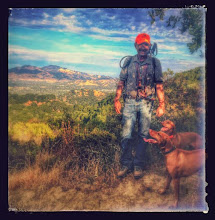One of the first things I put in the Jeep or motorhome when I go out to walk or field trial my dogs is my field dog first aid kit.
Here is a picture of Bailey with a cut pad and me putting my sock on his paw. Within two minutes it had fallen off.
Now I keep a good kit handy.
Here is a picture of Bailey with a cut pad and me putting my sock on his paw. Within two minutes it had fallen off.
Now I keep a good kit handy.
Article by Keith McCafferty.
No matter how watchful you are, your hunting dog may suffer any number of injuries when afield. Fortunately you can treat many of them yourself, saving you and your dog a lot of misery-not to mention veterinary bills.
Here's how to field-treat six common problems.
Also known as grass awns, these can be found nearly everywhere, especially early in the season. Check your dog's nose, ears, and eyes hourly, including under the lower eyelids, and remove seeds with fingers or tweezers and by washing the eyes with a sterile saline solution. If the dog paws at its face, shakes its head, or sneezes constantly, or if one of its ears droops, an awn may be lodged out of reach in the ear canal, nostril, or under the nictitating membrane of the eye, where it can cause an ulcer. This isn't a crisis, but get the dog to a vet.
Puncture wounds from fights should be cleaned and treated with antibiotics before the dog gets to a vet. Never close a puncture wound-this increases the chance of infection. To remove porcupine quills, use two hemostats: clamp one on the quill at the skin surface, pull, and clamp the other under it; repeat until the quill is out. Those in the mouth or near the eyes merit medical attention. Snakebites may not be immediately apparent. If the dog grows lethargic, assume the worst-administer an antihistamine and rush him to the vet.
Heat Illnesses
It's hotter at ground level than it is at human height; plus, in winter, the low angle of the sun beats against a dog's entire side, making heatstroke common among active ones. On hot days, carry 6 liters of water to hunt a single dog for three hours-4 liters to cool the dog down and the other 2 for drinking. Stumbling, rapid breathing, glassy eyes, and foaming are signs of heatstroke. Get the dog into the shade and submerge him in cool water if possible.
Barbed Wire
Unless they're very dirty, rips caused by barbed wire can be treated in the field. Muzzle the dog, clip the hair around the wound, and flush it with water followed by a sterile saline solution. Treat the wound with Betadine solution, staple it closed (you can get a skin staple gun from your vet), then fill the gaps with an antibiotic ointment. Administer a prescription oral antibiotic for 10 days, but check regularly for signs of infection.
Thorns and catus spines
If your dog is limping, one of these may be the reason. Check pads and between toes often, especially after a dog has chased a pheasant into thick cover. Remove thorns or cactus spines with a hemostat and treat the wounds with Betadine solution.
Pad Injuries
These occur when sand, shale, or sharp rocks chafe the bottom of the paw. Condition your dog's pads by incremental exposure and the application of a pad toughener, but always carry rubber dog boots when hunting rough terrain. Raw or torn pads should be cleaned, treated with Betadine solution, and slathered with antibiotic ointment. Superglue or veterinarian's glue can be applied to form a protective shield. Abraded pads need to be bandaged and booted if the dog continues to hunt.
Dog First Aid










No comments:
Post a Comment